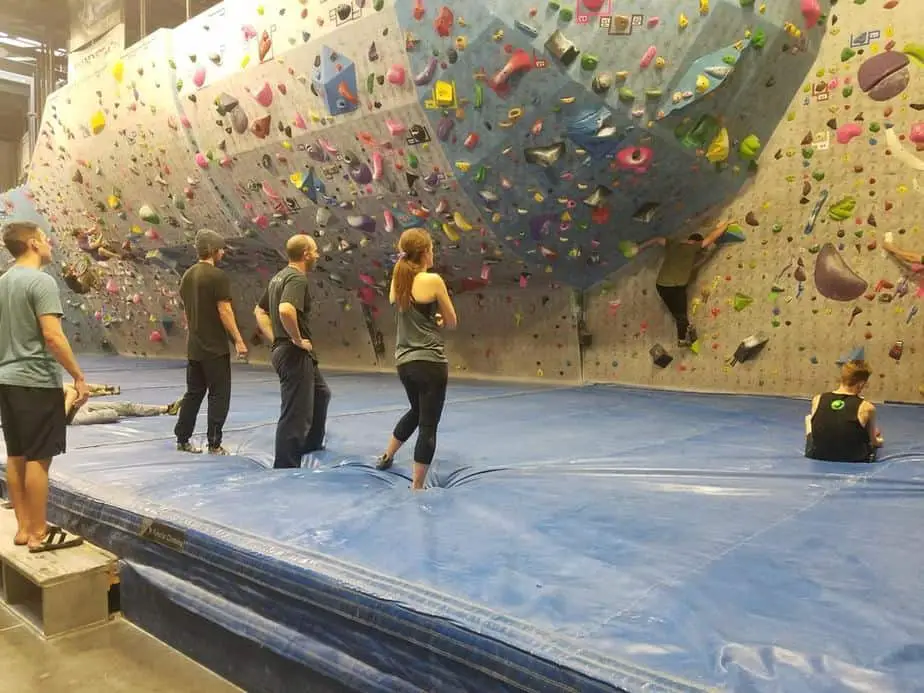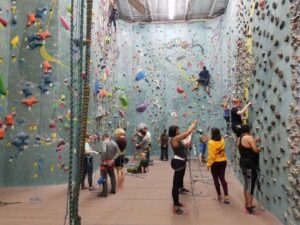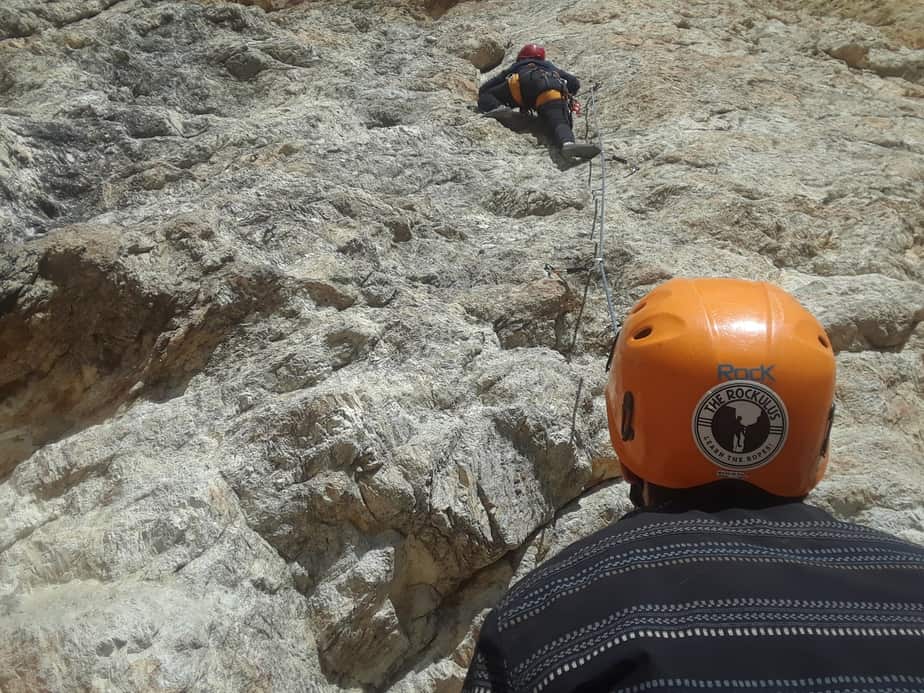If you are on social media, you’ve probably seen photos of people, from old highschool friends to A-list celebrities, participating in the sport of rock climbing. For a sport that was considered a fringe adventure activity even just a decade ago, it’s gained a lot of mainstream popularity in the last few years.
Climbing has become so popular thanks to the availability of indoor climbing gyms, which make climbing safe and accessible to novices and experts alike. Rock Climbing is also an excellent form of exercise in a positive social atmosphere.
Rock climbing is popular because it provides a fun and social way to get a great workout. The popularity of climbing, and specifically indoor climbing, corresponds with a rapidly increasing indoor climbing gym scene.
Additionally, thanks to the inclusion of the sport in the upcoming Tokyo Olympic games, rock climbing will gain even more exposure and likely more popularity in the years ahead.
Since climbing is now a common activity, and totally accessible to beginners, anyone should feel comfortable giving it a try. Read on to see why rock climbing is so popular, and why you should join in on the fun!
What Makes Rock Climbing So Popular
Most popular sports have a lot in common, and rock climbing is no exception; climbing provides a great workout, is accessible to all skill levels, is marketable, has a great social aspect, and there is a diverse collection of climbing heroes to provide inspiration.
Climbing has an unfortunate reputation as being a dangerous or extreme sport. This is largely because of its portrayal in the media, as well as the public’s misunderstanding of modern safety techniques.
These safety techniques, especially in indoor climbing, have brought rock climbing into mainstream and allowed everyone to participate- not just those adrenaline-junkies with little regard for life and limb (looking at you Alex Honnold).
If you’re skeptical of climbing’s safety record, or would like to learn more, check out my article Is Indoor Rock Climbing Dangerous?

Exercise
Rock climbing is a great workout. For many people, this would be a reason in and of itself to participate. The Health & Fitness Clubs Industry was around $96B in 2019 (1), which means a lot of people are trying to prioritize exercise.
Exercise is important for a healthy lifestyle, and is shown to release endorphins in the brain, which can make you feel happier! So for fitness enthusiasts just looking for a new way to stay in shape and feel great, rock climbing could just be another sport to try.
Unlike boring treadmill running and repeatedly lifting dumbbells though, climbing is a lot of fun and is a mental challenge as well as physical. Most people want to have fun while they exercise, even before the endorphins kick in. Rock climbing is an incredibly enjoyable sport, which is one of the main reasons for its popularity.
Rock climbing is like solving a puzzle. As you ascend the wall, you need to assess the holds available to you as you go, and figure out the best way forward. You need to make sure that as you climb upwards, you aren’t going to get stuck with the wrong hand or foot on a hold, or that you don’t tire out by not resting at the right times.
As opposed to other sports, such as running or swimming, where people often allow their thoughts to wander, climbing keeps your brain completely focused on the present moment. This intense focus can lead to a state called “flow”. Finding the “flow” state can be incredibly addictive, and chasing that feeling is what keeps many people invested in the sport for the long haul.
Rock climbers don’t need to be absolute physical specimens either; anyone who can climb a ladder can try rock climbing. Climbing walls come in varying levels of difficulty so that everyone can enjoy it.
Climbing also has a pretty quick learning curve, meaning that you can go from beginner to intermediate within a couple of weeks (5.6 to 5.9+ level). The growth of the fitness industry, fun of climbing, and mental focus all contribute to the popularity of climbing as a form of exercise. For more information on the health benefits of climbing, see the article Is Indoor Rock Climbing a Good Workout?
Growth of Climbing Gyms
The Climbing Business Journal reports that, as of 2018, there are around 500 climbing gyms in the US, with most of those popping up in the last decade (2). The increase in climbing gyms is both a cause and effect of the rising popularity of rock climbing.
Because the sport began outdoors and branched off of the more dangerous activity of mountaineering, it long maintained its image as a niche activity for adrenaline junkies. As people began climbing harder and harder however, and as technological advances made the sport safer, climbers began to develop ways to train indoors for climbing so that they could perform their best outside on real rock.
These early training centers eventually evolved into more standardized gym environments and eventually into the full-fledged training and fitness centers that are around now, attracting fitness enthusiasts of all backgrounds along with outdoor climbers looking to get stronger. Lots of gyms include free weights, yoga studios, and even Ninja Warrior training as well.

Climbing indoors has a lot of benefits. For one, climbing indoors is much safer thanks to padding on the floor, roving employees correcting mistakes, and equipment that is regularly inspected.
Additionally, there is a wide variety of climbing routes ranging from beginner to expert so that everyone can find something to climb. Expensive equipment, often a deterrent for new outdoors climbers, is available to rent at indoor gyms as well, making it easy for new people to try.
Today, many people start climbing at indoor facilities and might never go climbing outside. In this way, not only have climbing gyms increased the popularity of climbing, but they have created an entirely new subset of the sport of rock climbing as a whole.
Marketability
There is no denying the fact that the rise of climbing within social media and advertisements has contributed to the growing popularity of the sport. Both indoor and outdoor climbing have appealing aesthetics that lend themselves well to the creation of engaging content.
Outdoor climbing provides content creators with gorgeous backdrops, dramatic natural features, and ample opportunities for an epic pose, and giant advertisers have taken note. From Toyota to American Express, international brands have utilized images of outdoor climbing to sell their products (3).
If you have even a peripheral eye on popular culture, you heard about, and probably watched, the 2018 documentary film Free Solo, which featured professional climber Alex Honnold free-soloing El Capitan in Yosemite National Park.
The documentary, which went on to win an Oscar, featured spectacular video footage of Alex climbing in not just Yosemite, but in beautiful locations across the globe. The success of this film truly symbolized the transition of climbing from a fringe activity to one with real mainstream appeal.
While not as ideal as outdoor climbing for Time Square advertisements or IMAX theaters, indoor climbing provides bite-sized content that is perfect for social media consumption. The discipline of bouldering, for example, involves completing routes that go a maximum of 10-15 feet high, and often take under a minute to complete, making them the perfect content to post on Instagram if you want to show off your climbing abilities.
Additionally, many newer climbing gyms have clean lines, neutral walls, and brightly colored holds, creating a perfect aesthetic for #fitspiration content. Indoor climbing competitions are also starting to see a larger viewing audience, and videos of epic moves and routes from competitions have made the rounds on Instagram, Youtube, and other platforms.

Social Aspect
Another reason climbing is so popular is that it can be a great social activity. Roped climbing, both indoors and out, requires at least two people, but can also be enjoyed in small groups. It’s the perfect activity to do with a close friend or significant other, as it allows time to hang out while still getting a good workout in.
Bouldering is technically a discipline that can be enjoyed individually, but because the routes are so short, a long bouldering session inherently involves a lot of down time on the ground. This characteristic means it’s easy to socialize and meet people while bouldering, especially at a climbing gym, where a lot of people are in the same area and trying the same routes.
Climbing gyms have become hubs for climbing communities around the world, with many providing work areas, coffee shops, yoga, and full locker room facilities. The ability to enjoy climbing for both the exercise, as well as the social and lifestyle aspects, contribute to the popularity of rock climbing.
There is a growing movement within the climbing community to be more inclusive to new climbers, as well as to minority groups within the sport. Organizations and platforms such as Flash Foxy and Color the Crag help facilitate meetups for women and less-represented climbers, and most gyms strive to provide resources and a fun environment to everyone in their community.
The actions of these and many other organizations will help make climbing more accessible and enjoyable to all.
Sports Heroes
Every popular sport has its heroes, and climbing is no exception. Alex Honnold, the star of Free Solo, is probably the most well-known climber, and the first to really transcend the sport to find fame in mainstream culture. The co-director of Free Solo, Jimmy Chin, is also an accomplished climber who has found fame both within and outside of the climbing community.
Both of these climbers are often pictured climbing with Hollywood celebrities, including Jason Momoa, Jared Leto, and Brie Larson, all of whom are avid climbers in their own right. When people with platforms that large share images and videos of themselves climbing, it’s obvious that the popularity of the sport is destined to grow.
Other climbers have found a lot of success on social media, and their content contributes to the popularity of climbing. Magnus Midtbø is a former competitive climber who has almost three-quarters of a million subscribers on YouTube, where he posts a wide array of climbing-related content.
Adam Ondra, widely considered to be the best climber in the world, has also found a lot of success on YouTube in documenting his journey to the Olympics games.
Sasha DiGiulian, a champion competitive climber, has expanded upon her climbing career to become an ambassador for women in sports. Tommy Caldwell, who starred in the award-winning film The Dawn Wall, using his influence and platform to speak out on climate change, public land access, and other environmental issues.
Tokyo Olympic Games
The Olympic Games in Tokyo, Japan, now scheduled for the summer of 2021, have the potential to radically change the sport of climbing. Once climbing is on display for the entire world, there is no telling how much the popularity of the sport will grow.
Related Questions
When Did Climbing Become Popular? Rock Climbing entered the mainstream in the mid 2000’s as climbing gyms started to spring up all over the world. This allowed people geographically removed from traditional climbing areas to climb whenever they want to, and provided a safe and welcoming environment for new climbers to try the sport.
Why is Bouldering So Popular? Bouldering has become so popular because it requires less equipment and knowledge than rock climbing. It is also more social than rock climbing, as boulderers spend more time near each other on the ground. Many gyms and fitness centers have added bouldering areas, even though they don’t have space for roped climbing walls.
Sources:
- https://www.statista.com/topics/1141/health-and-fitness-clubs/#:~:text=The%20market%20size%20of%20the,billion%20U.S.%20dollars%20in%202019.
- https://www.climbingbusinessjournal.com/climbing-gyms-and-trends-2019/
- https://www.luerzersarchive.com/en/article/190/climbing–weird-new-ad-trend-und-.html

